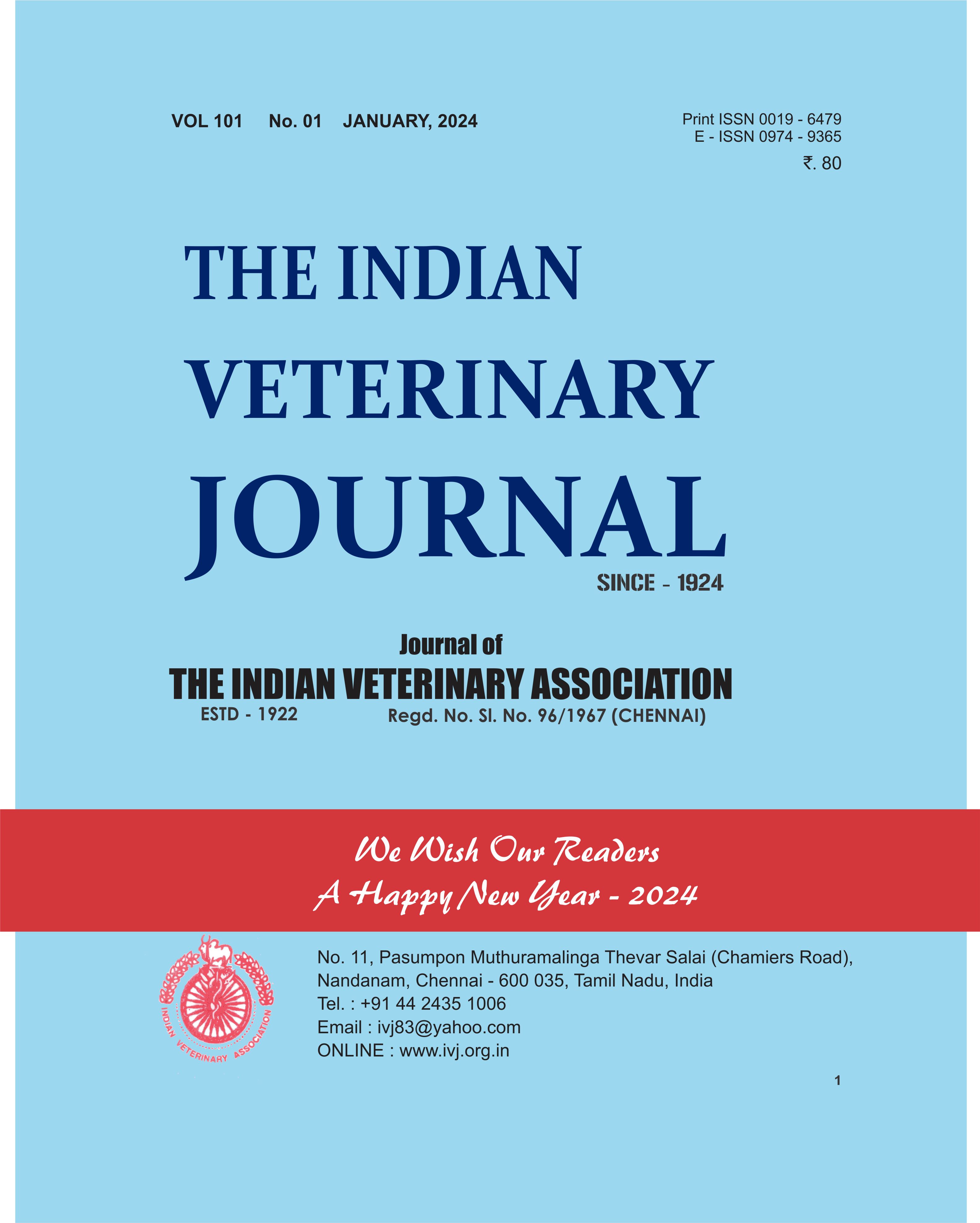Dystocia in Small Ruminants – A Retrospective Analysis
Keywords:
Dystocia, Cervical dilatation, Fetus, Caesarean sectionAbstract
A brief retrospective study of seventy small ruminants with history of dystocia was evaluated over a period of 10 months. The clinical cases of dystocia were categorized into fetal (n=44) and maternal causes (n=26). Fetal causes include faulty disposition (n=35) and oversized fetus (n=9) while, maternal causes include incomplete cervical dilatation (n=16) and uterine torsion (n=10). Sixty animals were relieved from dystocia by gentle traction and the rest 10 animals were subjected to caesarean section by lower left flank laparohysterotomy. In our study, it was observed that the major cause of dystocia due to fetal and maternal origin were faulty disposition (79.54%) and incomplete cervical dilatation (61.53%), respectively.
Downloads
References
Abdul-Rahman, L.Y., Al-Janabi, A.S. and Asofi, M.K. (1999). Causes of dystocia in Iraqi local goats reared in field stations. The Veterinarian.9: 8-21.
Al-Sultan, M.A.H. and Majeed, A.F. (1996). Ringwomb in relation to serum calcium and inorganicphosphorous in Iraqi Awassi ewes. Iraq. J. Vet. Sci. 9: 69-72
Aziz, D.M. and Taha, M.B. (1996) Dystocia in Awassi ewes: causes and treatments a review. Iraqi Journal of Veterinary Science.9: 1-12.
Bhattacharyya H.K, Mujeeb -u- R. Fazili, Fayaz A. Bhat, Bashir A. and Buchoo. (2015) Prevalence of Dystocia in Sheep and Goats: A Study of 70 Cases. Journalof advanced veterinary research.5 (1): 14-20.
Braun, W. (1997) Parturition and dystocia in the goat. In: Current therapy in large animal Theriogenology. 2nd Ed. Youngquist, R.S., W.B. Saunders Co., Philadelphia, USA. P. 555-558.
Brounts, S.H., Hawkins, J.F., Baird, A. N. and Glickman, L.T. (2004). Outcome and subsequent fertility of sheep and goats undergoing cesarean section because of dystocia: 110 cases (1981–2001). Journal of the American Veterinary Medical Association.224: 275-281.
Ghosh, A., Yeasmina, F. and Alam, M.G.S. (1992). Studies of ringwomb in Black Bengal goats. Theriogenology.37: 527-532.
Hanie, E.A.A. (2006) Obstetrical Procedures. In : Large Animal Clinical Procedures for Veterinary Technicians. Elsevier, Mosby, Missouri. pp. 413-31.
Jackson, P.G.G. (2004) Dystocia in the Ewe. In: Hand Book of Veterinary Obstetrics. 2nd Edn. W.B. Saunders Co. Ltd., London. pp. 105-24
Majeed, A.F. and Taha, M.B. (1989) Preliminary study on treatment of ringwomb in Iraqi goats. Animal Reproduction Science.18: 199-203.
Mcsporran, K.D. (1980) Dystocia in sheep. In: Current Therapy in Theriogenology. Morrow, DA (2nd Ed.). W.B. Saunders Co., Philadelphia. pp. 916-918.
Noakes, D.E., Parkinson, T.J. and England, G.C.W. (2009) Maternal Dystocia: causes and treatment. In: Veterinary Reproduction and Obstetrics (Ed. David Noakes), 9th edn., Saunders Elsevier, UK, pp. 233-234 and 272-273.
Purohit, G.N., Gupta, A.K., Gaur, M., Sharma, A. and Bihani, D.K. (2006) Periparturient, disorders in goats- a retrospective analysis of 324 cases. Dairy Goat J. 84: 24-33
Rahim, A.T. and Arthur, G.H. (1982) Obstetrical conditions in goats. Cornell Veterinarian72: 279- 84.
Roberts, S.J. (1971) Obstetrical Operations. In: Veterinary Obstetrics and Genital Diseases (Ed., S.J. Roberts), Indian Reprint 2004, 2 ed, CBS Publishers and Distributors Pvt. Ltd. India, pp. 255-260
Rook, J.S., Scholman, G., Wing-Proctor, S. and Shea, M. (1990) Diagnosis and control of neonatallosses in sheep. Veterinary Clinics of North America: Food Animal Practice.6: 531-562
Scott P.R. (1989) Ovine caesarean operations: A study of 137 field cases. British Veterinary Journal. 145: 558-564.
Thomas, J.O. (1990) Survey of the causes of dystocia in sheep. Vet. Rec. 127: 574-75
